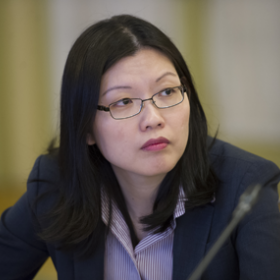
China's Clean Energy Ambitions
On October 1, 2010, the EastWest Institute, with support from the China-United States Exchange Foundation, sponsored a discussion with Professor Xu Kuangdi on the status and development of China’s energy sector. Professor Xu is a leading scientist, the former mayor of Shanghai, and the former Vice Chairman of the Chinese People’s Political Consultative Conference (CPPCC). He is currently one of China’s most outspoken advocates for the development of clean energy technology.
In his presentation, Professor Xu highlighted China’s tremendous economic growth in the past 20 years and consequently the significant increase in need for energy resources. Although China already has established itself as a worldwide leader in resources such as wind and solar energy, the country still depends predominantly on coal. Professor Xu referenced Kuznets curve, a model in which a country at the outset is at the bottom of the curve—economically poor but environmentally clean. When the country begins to develop economically, environmental degradation also increases until the country reaches the top of the curve and thereby the highest level of pollution. As the country’s economy continues to grow, manufacturing eventually is replaced by other industries, and pollution subsequently decreases. Professor Xu pointed out that it is impossible for a country to develop economically without some increase in pollution. China, he believes, is currently in the middle of the upward curve and likely to peak at its worst level of pollution around 2030. But although environmental degradation is unavoidable, the severity of the pollution is controllable, and thus China’s most urgent task is to mitigate the damage to the environment by reducing energy consumption and carbon emissions.
Professor Xu’s presentation and subsequent discussion with participants raised a number of approaches China could implement to develop clean energy resources, including the following:
- Increase BTB recycling, a process that converts waste into energy. Professor Xu reported that one BTB recycling plant can recycle 50 kilotons of plastic, saving 300 kilotons of oil and reducing carbon emission by 150 kilotons.
- Construct energy-saving cities and buildings by using, for example, light-emitting diode (LED) bulbs instead of conventional bulbs.
- Continue the development of hydropower, like that of the Three Gorges project that is saving 50 million tons of coal each year.
- Increase China’s capacity for solar energy, capitalizing in particular on the abundant sunlight received in the northwest areas of the country.
- Decrease the number of cars in cities by requiring purchasers to bid for licenses.
- Place the onus for reducing electricity use on the user by raising costs for those who exceed a certain amount of usage.
- Increase local government officials’ commitment to environmental protection by encouraging the public to report on environmental degradation via the internet.
Professor Xu concluded with the reminder that technological advancement takes time. Therefore, although changes in China’s energy consumption cannot be rushed, he expressed confidence that China can and will find the solutions to its energy needs.

